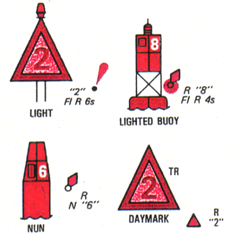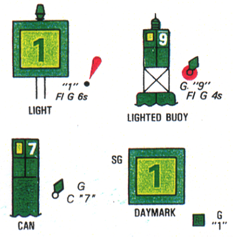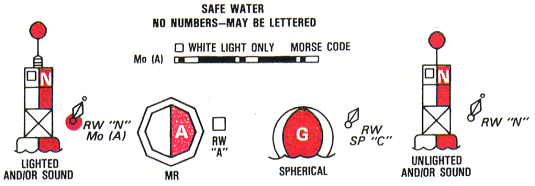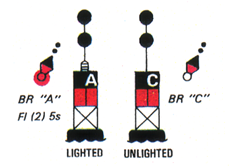Download Boating Tip #18: Aids to Navigation (PDF format, 222KB)
Aids to navigation include fixed beacons or day marks. They include floating buoys, which can be pillar, spar, spherical or barrel shaped, cone shaped nuns or cylindrical cans. They can be used as lateral marks, mid channel marks, preferred channel marks where there are junctions and bifurcations, safe water marks, isolated danger marks, special marks, information and regulatory marks, and ranges. Some aids to navigation are lit, including lighted buoys, lighthouses, light ships, and LNBs (large navigational buoys).
- Buoys
- Buoys consist of a float, mooring chain and anchor. They may be equipped with lights and/or sound signals such as bells, gongs, or whistles.
In the Lateral System used in the U.S. and in IALA region B, which includes all of the Americas, the numbers on buoys increase as you head in from the sea (except on Western Rivers and the Intracoastal Waterway).
- Beacons
- Fixed beacons are usually erected in shallow water or on breakwalls. They are more reliable than buoys because they don’t move. Their colors match buoys that would be placed in the same locations.
- Lights
- Lights used as navigational aids include lighted buoys, lighted beacons, lighted superbuoys, lighted offshore platforms, lightships, and lighthouses. Lights have distinguishing colors, characteristics, and periods. Light colors are usually red, green, white, or yellow. Period of a light is the time in seconds that it takes to complete a light cycle. Elevations of lights are indicated on charts and in light lists. The nominal range of a light, or how far the light can be seen in clear weather, is also charted.
Some lights, called directional lights, have sectors. White light is used to indicate safe passage areas. Colored glass panels may be used to obscure or shield a sector of light or show light in another color (usually red to indicate danger areas).
| Light Characteristics | |
|---|---|
| Fixed | Always on |
| Occulting | Duration of light is longer than the duration of darkness |
| Isophase | Equal duration of light and darkness |
| Flashing | Duration of light is shorter than duration of darkness |
| Quick | 50 – 79 flashes per minute |
| Very quick | 80 – 159 flashes per minute |
| Ultra quick | 160 or more flashes per minute |
- Starboard Side Aids
- Red buoys are found on the starboard side of a channel when entering from seaward and can be lighted buoys, nuns, or triangular daymarks. Red buoys are always evenly numbered. Red buoys, if lit, have red or white lights, and the light pattern can be fixed, flashing, occulting, quick–flashing, or of equal intervals. Use the memory aid “Red Right Returning” to help you remember to keep red buoys on your starboard side when entering from seaward.

- Port Side Aids
- Green buoys are found on the port side of a channel when entering from seaward and can be lighted buoys, cans, or square daymarks. Green buoys are always odd numbered. Green buoys, if lit, have green lights, and the light pattern can be fixed, flashing (which is the most common), occulting, quick–flashing, or of equal intervals. Under the old buoyage system used before 1989, green buoys were black, and if lit, were lit with white lights.

- Horizontally Striped Aids
- Horizontally striped aids are also known as preferred channel marks. They have red and green horizontal bands that mark junctions, bifurcations, or obstructions that can be passed safely on either side. Junctions come together and bifurcations split. The preferred channel is to starboard when entering from seaward if the top band is green, and to port if the top band is red. The buoys can be lighted buoys, cans or square daymarks if the topmost band is green, or lighted buoys, nuns or triangular daymarks if the top band is red. The light pattern is composite group flashing (2 + 1).


- Vertically Striped Aids
- Vertically striped aids mark safe water. They are red and white vertically striped. They are not numbered, but may be lettered. They can be sphere shaped buoys, lighted and / or sound buoys, octagonal shaped marks. They are usually located in the middle of a channel. If lit, they have a white light which flashes a distinctive Morse code A (dot dash, dot dash, dot dash).

- Special Marks
- Special marks are yellow colored buoys, daymarks, cans or nuns. They are used to mark anchorages, military exercise areas, scientific data collection areas, traffic separation schemes, cables, diving areas, or other areas of special interest. Special marks are lettered rather than numbered, and if lit, have yellow lights which have a fixed or flashing characteristic.

- Isolated Dangers
- Isolated danger buoys or marks identify hazards. They are horizontally banded – black, red, black, and have two black, spherical topmarks placed one on top of each other. They are not numbered, but may be lettered. They have white lights and their light characteristic is Fl (2) 5 sec or two flashes then an eclipse period of 5 seconds.

- Information and Regulatory Markers
- Information and regulatory markers provide information, instructions, notify boaters of dangers, and mark areas with special regulations, restrictions or which are off–limits. They are often used to indicate swimming areas, or to inform boaters that they are entering an area where speed limits are enforced. They are white in color with orange markings. For instance, white buoys with orange crossed diamonds indicate exclusion areas. White buoys with orange open diamonds indicate danger areas. White buoys with orange crossed circles indicate restricted operations. If lit, information and regulatory markers have white lights, and may use any rhythm except flashing or quick flashing.

Every time I stumble upon a great article I go ahead and do one of three thing:1.Forward it to all the relevant friends.2.Bookmark it in all my favorite social bookmarking sites.3.Make sure to return to the site where I first read the post.After reading this post I am seriously thinking of going ahead and doing all of the above.